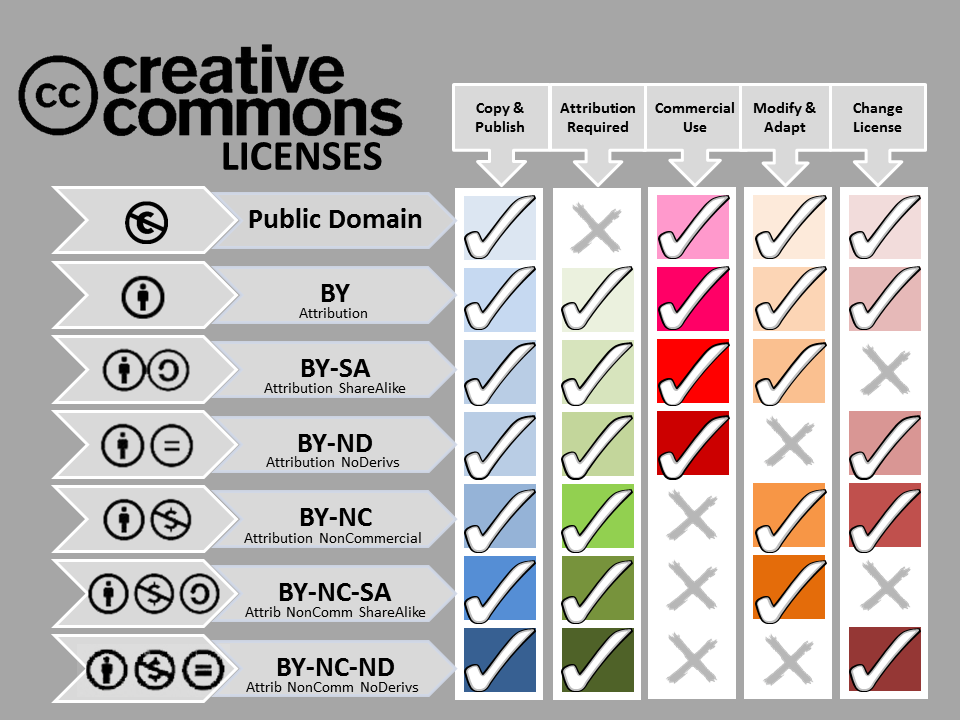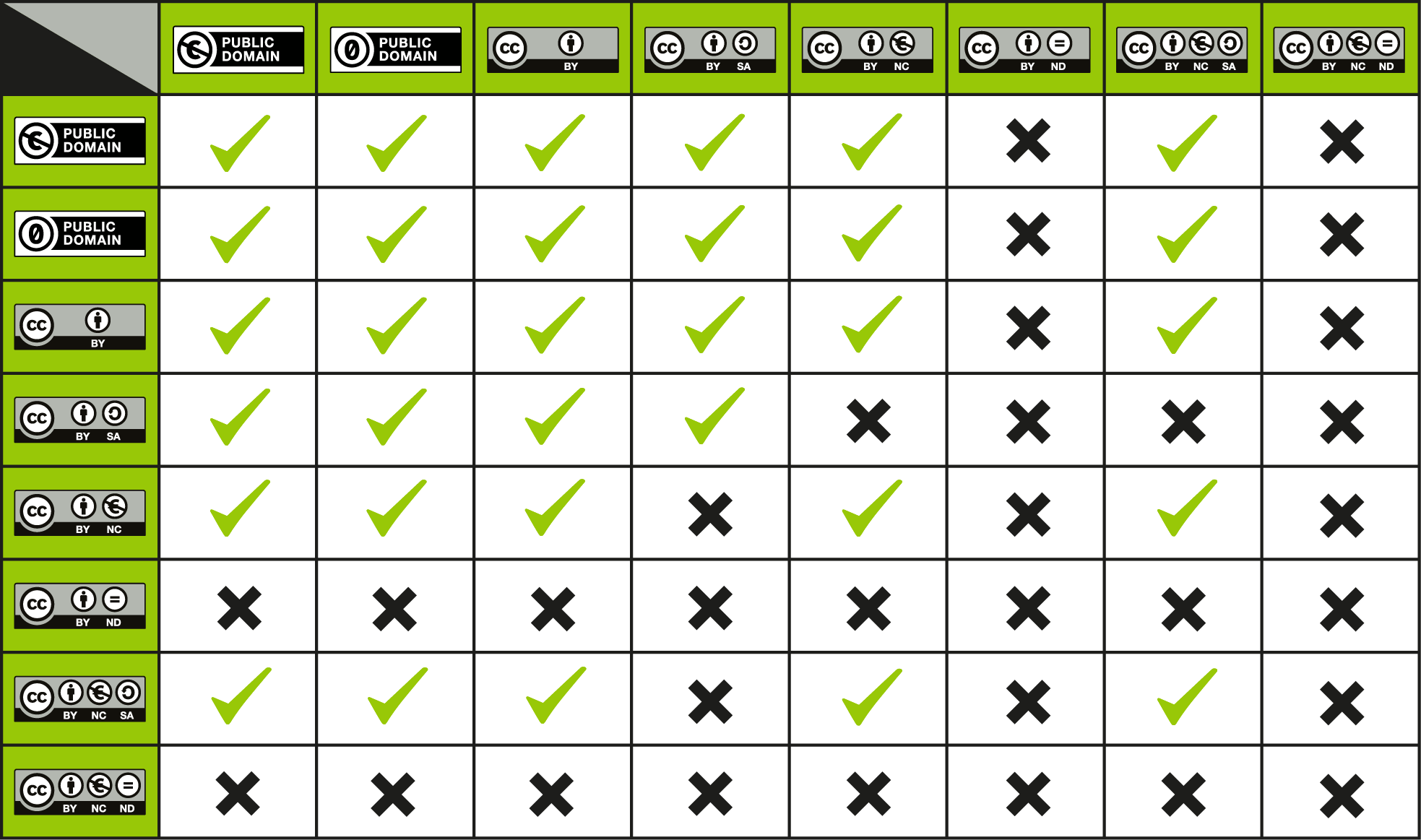3 Educational Resources and Open Licensing
Choosing an Open License
Project Leads with grant-funded OERs must choose an Open License that is the least restrictive possible given the nature of the product and given any other included resources (Unless there are required restrictions such as with Indigenous cultural restrictions.)
Creative Commons Licenses are the typical choice for OERs. There are many open license options to choose from. Project Leads may desire to meet with the OEP Program Manager and the University Copy Right Officer to determine the appropriate open license for their project. Contact the OEP Program Manager to request a meeting.
How to Openly License Digital Resources
To freely share your creative work, including open textbooks, without requests for permission, you can dedicate your work to the public domain, or license it openly. The Archer Library has a page with information for faculty and students at https://www.uregina.ca/copyright/. For help on copyright, visit the copyright contact information page at https://www.uregina.ca/copyright/contact/index.html.
Public Domain
Items in the public domain are not protected by intellectual property laws, including copyright, trademark, or patent laws. Public domain belongs to the public – no individual can claim any right to the material, and it can be used by anyone without obtaining permission.
Here are four of the typical ways that works end up in the public domain:
- The copyright has expired
- The existing copyright owner failed to renew the copyright
- The work was dedicated to the public domain
- Copyright law is not applicable to this type of work (example: short phrases, facts and theories, and U.S. government works)
Copyright law varies from country to country, and a work can be in the public domain in one country, but not necessarily in another. All users and creators need to be aware of this.
The 5 R’s of OER and CC Licensing
OERs are resources that are freely available for anyone to use, adapt, distribute, translate and share with no or very minimal restrictions. They are not only about cost savings but are developed by individuals who share the belief that the world’s knowledge is a public good and should be accessible to all. The 5 R’s of OER are:
- Retain: you can make and own copies of the resource
- Reuse: you can use the resource in your own context
- Revise: you can adapt, modify, translated and improve the resource
- Remix: you can combine and recombine the resource with other material
- Redistribute: you can share the resource with others
Anyone using Creative Commons licenses needs to be aware of how these licenses allow for reuse. The image below shows this for each license.

How to Combine Licenses
When selecting OER under a Creative Commons license, the OER user must also be aware of how the resource created from the existing source can be licensed. The following image shows the different variations possible. The license of the original OER is shown on the left. Possible licensing options of the derivatives are shown in the top row.

You can download a Creative Common license quick reference sheet for your personal use. The following videos gives some information on combining Creative Commons licenses.
For some additional information on copyright related to the Canadian higher educational sector, the University of Alberta library has a series of modules available at the link https://sites.library.ualberta.ca/copyright/modules/access-copyright-v-york/.
Creative Commons vs Open Source Licensing
Before moving on from this section on licensing, it is important to note that there are other open licenses besides the Creative Commons Licenses. While most recently created OER in higher education uses Creative Commons licenses, there are still those that use other open licenses. Below is a list of examples of some OER licensed using other open license options.
- A First Course in Linear Algebra by Rob Beezer. Licensed under a GNU Free Documentation License (GFDL).
- Discover Linear Algebra by Jeremy Sylvestre. Licensed under a GNU Free Documentation License (GFDL).
- Linear Algebra Resources by Thomas R. Shemanske. Licensed under a GNU Free Documentation License (GFDL).
- Abstract Algebra: Theory and Applications by Tom Judson. Licensed under a GNU Free Documentation License (GFDL).
- An IBL Introduction to Geometries by Mark A. Fitch. Licensed under a GNU Free Documentation License (GFDL).
- Combinatorics Through Guided Discovery by Kenneth Bogart. Licensed under a GNU Free Documentation Licence (FDL).
- The Ordinary Differential Equations Project by Thomas W. Judson. Licensed under a GNU Free Documentation License (GFDL).
There are other open resources listed under other open source licenses besides the Gnu Free Documentation Licence (GFDL). For a complete list of open source licenses, the interested reader can visit Wikipedia which provides additional detail on specific licenses with relevant links. The Open Source Initiative is a good place to get information on open licenses and open standards. The site also provides an extensive list of all open source licenses. Many of the open source licenses listed are applied to software which is not surprising given the history of the open source movement. However, there are a number of licenses that can be used for open content in higher education as listed above.
Currently, most open education efforts in higher education produce open resources licensed under Creative Commons Licenses. At the start of this chapter, the discussion on Creative Commons licensing pointed to permissions given to the user to remix or adapt resources using the 5 R framework. A question one could ask is the difference between the CC and open source licenses. The one key difference between these two license types is that the open source licenses require that the creator provide the source code of the resource. For the seven resource listed in above under a Gnu Free Documentation license, anyone interested in adapting one of these resources can access and download the source code from the respective webpage.
The original definition of free software under the Open Source movement included four freedoms (See Wikipedia Four Essential Freedoms of Free Software). The key issue to note is that Freedom 1 and 3 require source code to be available because studying and modifying software without its editable source is impractical. This is a key element of the open-source movement – providing source code for each project so that others can modify as needed.
Creative Commons licenses do not provide such a stipulation. The creator of a resource allows some or all 5 Rs by choosing the appropriate CC license. This means a user can openly license a resource created using any technology tool (commercial or open-source) and then release it to the OER community. Unfortunately, this leads to potential problems with the openness of the shared resource. Commercial technologies often use proprietary file formats that place restrictions on editing.
Maintaining Openness
Open and Proprietary File Formats
It is helpful here to digress to a brief conversation on file formats. All shared resources are provided in one or several popular file formats. The resource, Modifying an Open Textbook: What You Need to Know published through the Open Education Network provides details on file formats. When creating openly licensed resources, it is probably best to use open file formats so that a user does not need to own proprietary software for editing.
An OER creator needs to be careful with the selection of technologies and file formats so that once resources are shared, they truly remain open and editable for as many people as possible. This is not possible with many proprietary creation technologies and their accompanying file formats.
One common example of a file format used extensively throughout the OER community is Portable Document Format or PDF. While resources in this format are readable on all platforms, they are not editable in that format. Many OER users wishing to adapt resources from this format discover that PDF files are not editable without purchasing specific tools.
The ALMS Framework
While open licenses provide users with legal permission to engage in the 5R activities, many open content publishers make technical choices that interfere with a user’s ability to engage in those same activities. The ALMS Framework provides a way of thinking about those technical choices and understanding the degree to which they enable or impede a user’s ability to engage in the 5R activities permitted by open licenses. Here are the descriptions of acronym.
- Access to editing tools
- Level of expertise required to revise or remix
- Meaningfully able to edit
- Source-file access
For more details, the interested reader is referred to the resource, Modifying an Open Textbook: What You Need to Know by the Open Education Network.
References
Hilton, J., Wiley, D., Stein, J., and Johnson, A. (2010). The Four R’s of openness and ALMS Analysis: Frameworks for open educational resources. Open learning: The Journal of Open and Distance Learning, 25(1), 37-44.
Modifying an Open Textbook: What You Need to Know by Open Education Network is licensed under a Creative Commons Attribution 4.0 International License, except where otherwise noted.
Tools for Creating OER: Selecting Digital Technologies by Isaac Mulolani is licensed under a Creative Commons Attribution 4.0 International License, except where otherwise noted.

